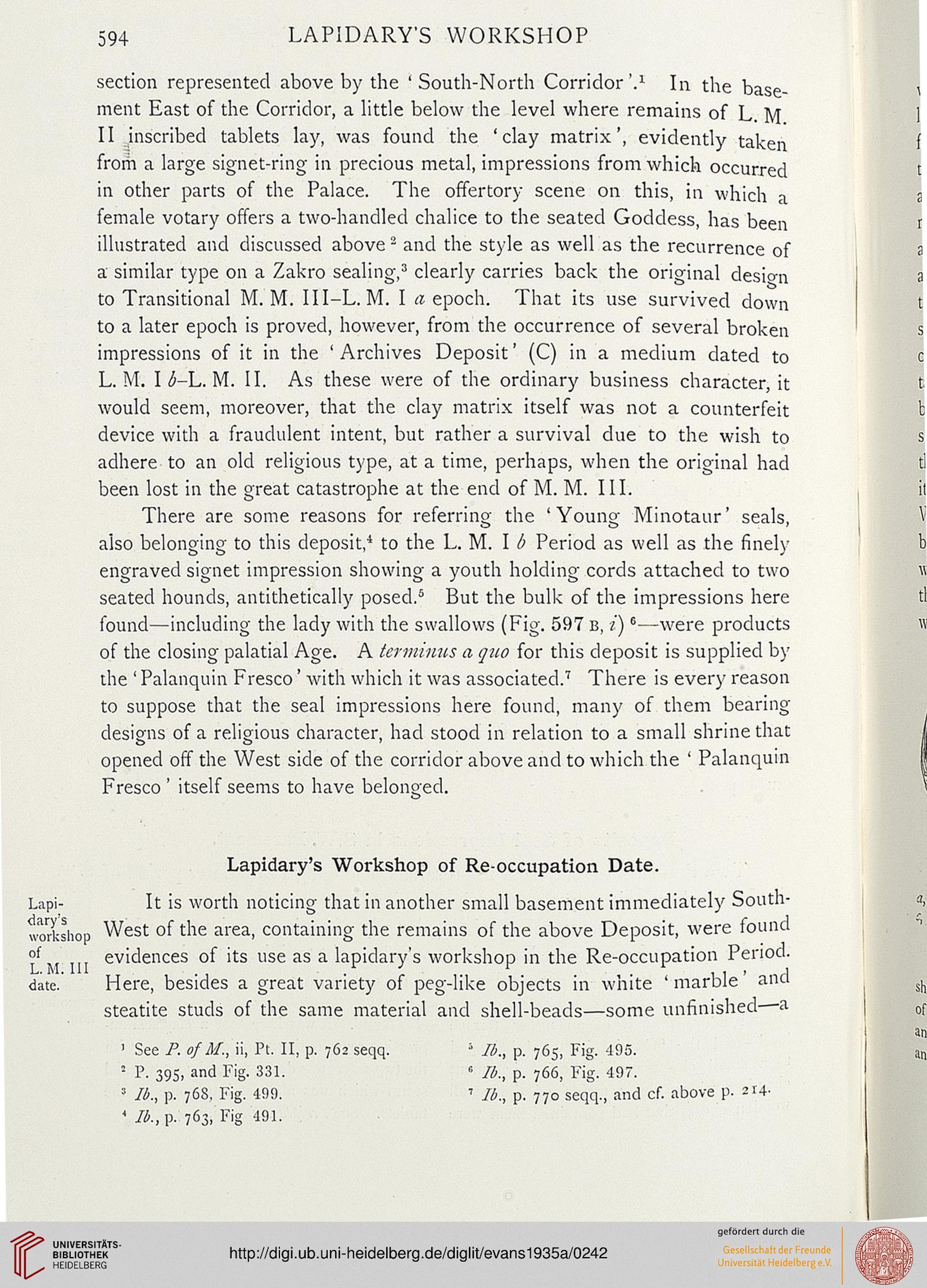594
LAPIDARY'S WORKSHOP
section represented above by the ' South-North Corridor'.1 In the base-
ment East of the Corridor, a little below the level where remains of L. M
II inscribed tablets lay, was found the 'clay matrix', evidently taken
from a large signet-ring in precious metal, impressions from which occurred
in other parts of the Palace. The offertory scene on this, in which a
female votary offers a two-handled chalice to the seated Goddess, has been
illustrated and discussed above2 and the style as well as the recurrence of
a similar type on a Zakro sealing,3 clearly carries back the original design
to Transitional M. M. Ill—L. M. I a epoch. That its use survived down
to a later epoch is proved, however, from the occurrence of several broken
impressions of it in the 'Archives Deposit' (C) in a medium dated to
L. M. I i-L. M. II. As these were of the ordinary business character, it
would seem, moreover, that the clay matrix itself was not a counterfeit
device with a fraudulent intent, but rather a survival due to the wish to
adhere to an old religious type, at a time, perhaps, when the original had
been lost in the great catastrophe at the end of M. M. III.
There are some reasons for referring the 'Young Minotaur' seals,
also belonging to this deposit,4 to the L. M. I b Period as well as the finely
engraved signet impression showing a youth holding cords attached to two
seated hounds, antithetically posed.5 But the bulk of the impressions here
found—including the lady with the swallows (Fig. 597 B, t) °—were products
of the closing palatial Age. A terminus a quo for this deposit is supplied by
the ' Palanquin Fresco' with which it was associated.7 There is every reason
to suppose that the seal impressions here found, many of them bearing
designs of a religious character, had stood in relation to a small shrine that
opened off the West side of the corridor above and to which the ' Palanquin
Fresco ' itself seems to have belonged.
Lapidary's Workshop of Re-occupation Date.
Lapi- It is worth noticing that in another small basement immediately South-
workshop West of the area, containing the remains of the above Deposit, were found
of ,, evidences of its use as a lapidary's workshop in the Re-occupation Period.
L.M. Ill . J l . , , 1
date. Here, besides a great variety of peg-like objects in white ' marble ana
steatite studs of the same material and shell-beads—some unfinished a
See P. of M., ii, Pt. II, p. 762 seqq.
P. 395, and Fig. 331.
lb., p. 768, Fig. 199.
A, p. 763, Fig 491.
' lb., p. 765, Fig. 495.
• lb., p. ;6S, Fig. 497.
' lb., p. 770 seqq., and cf. above p. 2'4-
LAPIDARY'S WORKSHOP
section represented above by the ' South-North Corridor'.1 In the base-
ment East of the Corridor, a little below the level where remains of L. M
II inscribed tablets lay, was found the 'clay matrix', evidently taken
from a large signet-ring in precious metal, impressions from which occurred
in other parts of the Palace. The offertory scene on this, in which a
female votary offers a two-handled chalice to the seated Goddess, has been
illustrated and discussed above2 and the style as well as the recurrence of
a similar type on a Zakro sealing,3 clearly carries back the original design
to Transitional M. M. Ill—L. M. I a epoch. That its use survived down
to a later epoch is proved, however, from the occurrence of several broken
impressions of it in the 'Archives Deposit' (C) in a medium dated to
L. M. I i-L. M. II. As these were of the ordinary business character, it
would seem, moreover, that the clay matrix itself was not a counterfeit
device with a fraudulent intent, but rather a survival due to the wish to
adhere to an old religious type, at a time, perhaps, when the original had
been lost in the great catastrophe at the end of M. M. III.
There are some reasons for referring the 'Young Minotaur' seals,
also belonging to this deposit,4 to the L. M. I b Period as well as the finely
engraved signet impression showing a youth holding cords attached to two
seated hounds, antithetically posed.5 But the bulk of the impressions here
found—including the lady with the swallows (Fig. 597 B, t) °—were products
of the closing palatial Age. A terminus a quo for this deposit is supplied by
the ' Palanquin Fresco' with which it was associated.7 There is every reason
to suppose that the seal impressions here found, many of them bearing
designs of a religious character, had stood in relation to a small shrine that
opened off the West side of the corridor above and to which the ' Palanquin
Fresco ' itself seems to have belonged.
Lapidary's Workshop of Re-occupation Date.
Lapi- It is worth noticing that in another small basement immediately South-
workshop West of the area, containing the remains of the above Deposit, were found
of ,, evidences of its use as a lapidary's workshop in the Re-occupation Period.
L.M. Ill . J l . , , 1
date. Here, besides a great variety of peg-like objects in white ' marble ana
steatite studs of the same material and shell-beads—some unfinished a
See P. of M., ii, Pt. II, p. 762 seqq.
P. 395, and Fig. 331.
lb., p. 768, Fig. 199.
A, p. 763, Fig 491.
' lb., p. 765, Fig. 495.
• lb., p. ;6S, Fig. 497.
' lb., p. 770 seqq., and cf. above p. 2'4-





